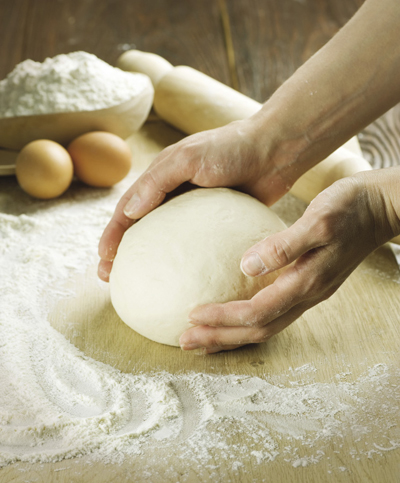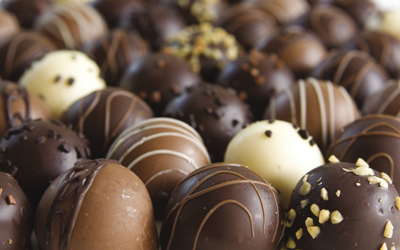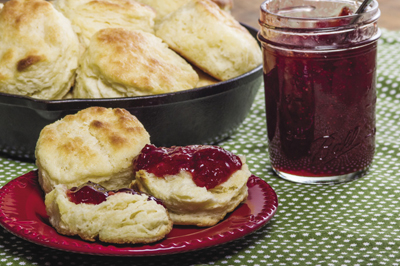High-Altitude Cooking
Guide E-215
Revised by Nancy C. Flores and Cindy Schlenker Davies
College of Agricultural, Consumer and Environmental Sciences, New Mexico State University
Authors: Respectively, Extension Food Technology Specialist, Department of Extension Family and Consumer Sciences; and County Program Director/Extension Home Economist, Bernalillo County Extension Office, New Mexico State University. (Print friendly PDF)
Introduction
High altitude presents several challenges when preparing certain foods. At high altitudes, leavened products such as breads using yeast, baking powder/soda, egg whites, or steam rise more rapidly and often collapse and are not fully cooked. Foods such as vegetables and stews cooked with moist heat take much longer to cook at high altitudes.
The air pressure is lower at higher altitudes. Atmospheric (air) pressure is 14.7 pounds per square inch (psi) at sea level, while at 5,000 ft elevation it is 12.28 psi, and at 10,000 ft is 10.2 psi. Therefore, at higher altitudes the atmospheric pressure is less on both leavened products and the surface of boiling liquids.
As atmospheric pressure decreases, water boils at lower temperatures. At sea level, it boils at 212°F, while each 500-ft increase in altitude causes a drop of about 1°F in the boiling point of water. At very high altitudes, more time is required for food to reach the desired internal cooking temperature. For example an apple baked in an oven set at 350°F will reach an internal temperature of 200°F in 20 minutes in Las Cruces, NM (3,500 ft elevation), while in Taos Ski Valley, NM (10,000 ft elevation) it will take 45 minutes to reach that same temperature. Appendix I on page 7 provides elevations of many cities and towns in New Mexico.
Although not directly related to altitude, humidity is a factor affecting cooked and baked foods. In New Mexico, the relative humidity can vary from 10% (very dry) to 75% (humid) over the course of the year, dropping as low as 4% and reaching as high as 99%1. Low relative humidity can cause ingredients such as flour to dry out and may produce dry, crumbly baked products. Flour may need a “rest” time to fully hydrate before baking.
The following guidelines will hopefully reduce the number of failures in baked and cooked foods frequently experienced by those living at high altitudes with low humidity.

© Subbotina | Dreamstime.com
Foods Cooked With Moisture
Vegetables, legumes, pot roasts, soups, stews, and other foods cooked with moisture at 5,000 ft elevation or above require additional cooking time. Vegetable cookery is greatly affected by vegetable particle size, variety, and maturity. Adjustments must be made accordingly at any elevation. Preparation time can be reduced by 25 to 35% by using a pressure cooker/saucepan. In a pressurized vessel, the temperature of boiling water increases rapidly as pressure builds within the sealed container.
Meat cooked by simmering or braising requires additional time at higher elevations. In general, 25% more time may be required at 5,000 ft than at sea level. Sea-level cooking times and temperatures can be used when oven roasting meats (dry cooking) because oven temperatures are not affected by elevation changes.
The traditional 3-minute soft-boiled egg may take 5 to 6 minutes at high elevations, and hard-cooked eggs also require additional time. To cook hard-boiled eggs, place cold eggs in a saucepan and cover with cool tap water. Cover and set heat on high. When water temperature approaches a gentle simmer, reduce heat to a low setting. At 5,000 ft it will take about 25 minutes for eggs to hard cook.

© Deborah Reny | Dreamstime.com
Candies And Frostings
Boiling causes a loss of moisture through evaporation and concentrates the liquid; thus, the lower the boiling point, the sooner evaporation begins. Depending on the candy or sugar mixture, the results may become “sugary” or hard as the sugar re-crystallizes.
At sea level, water boils at 212°F, but at high elevations, all liquids boil at temperatures below 212°F. This requires adjustments for candy and frosting recipes, which generally use the standard 212°F boiling point for water.
Confectionary recipes should be adjusted for elevation by reducing the “finish” temperature. Using a candy thermometer, first test the temperature at which water boils. The finish temperature should be reduced by the difference between your water boiling temperature and 212°F (Table 1). While weather conditions may cause minor changes from day to day, the range is usually slight. Compare your temperature measurements and cold-water test results, and record your adjustments in your cookbook or on recipe cards to keep track of time, temperature, and the quality of the final product. The cold-water test or a candy thermometer are two ways to test for finish. When the cold-water test is used, it will be necessary to learn the feel of the mixture at different stages (soft ball, hard ball, crack, etc). Table 1 indicates adjustments for various elevations.
At 5,000 ft elevation, water boils at approximately 202°F, 10°F less than at sea level; the finish temperature for candies or frostings should therefore be reduced by 10°F. For example, if a sea-level recipe for creamy fudge gives a finish temperature of 238°F, the corrected thermometer reading would be 228°F at 5,000 ft. The cold-water test is reliable at any elevation since it depends solely upon the appearance of the candy in cold water.
Rocky Mountain Frosting
1 cup sugar
1/4 cup water
1/4 cup white corn syrup
1 egg white
2 marshmallows
1/2 teaspoon vanilla extract
1/4 teaspoon almond extract
Cook sugar, water, and corn syrup until mixture forms a firm ball in cold water. Beat egg white until it forms soft peaks that droop slightly. Cut marshmallows into eighths and add to sugar mixture.
Gradually pour hot syrup into egg white mixture, beating continuously until icing holds its shape and is practically cold. Add vanilla and almond extracts and spread on cool cake. This frosting recipe should cover the top and sides of a 9-inch two-layer cake.
|
Table 1. Adjustments for Frostings and Candies |
|||||
|
Product |
Cold-water test |
Finish temperature |
|||
|
Sea level |
2,000 ft |
5,000 ft |
7,500 ft |
||
|
Creamy candies and fillings |
Soft ball |
234–240°F |
230–236°F |
224–230°F |
219–225°F |
|
Chewy candies |
Firm ball |
242–248°F |
238–244°F |
232–238°F |
227–233°F |
|
Pulled candies, fillings, and frostings with egg whites |
Hard ball |
250–268°F |
246–264°F |
240–258°F |
235–253°F |
|
Toffees |
Soft crack |
270–290°F |
266–286°F |
260–280°F |
255–275°F |
|
Brittles |
Hard crack |
300–310°F |
296–306°F |
290–300°F |
285–295°F |
|
Water, rolling boil temperature |
212°F |
208°F |
202°F |
198°F |
|
Jelly
At sea level, the finish temperature for jelly is 220°F, or 8°F above the boiling point of water. At 5,000 ft, water usually boils at 202°F (10° below normal), so jelly should be cooked to 210°F.
The “sheet” test remains reliable at all elevations. Use a metal spoon to remove some of the jelly from the pot. Turn the spoon sideways so they jelly flows off the spoon. As the jelly reaches the proper thickness, individual drops will run together into a “sheet” that breaks cleanly off the edge of the spoon. Please refer to Extension publications for specific jelly recipes and processing procedures (https://pubs.nmsu.edu/_e/#preservation).

© Zigzagmtart | Dreamstime.com
Deep-Fat Frying
Deep-fat frying vaporizes the liquids in foods, and liquids vaporize at lower temperatures at higher elevations. To prevent fried foods from being dry when cooked at high elevations, decrease the frying temperature 2–3°F for each 1,000 ft of elevation. For example, fry doughnuts at 350–360°F at 5,000 ft, rather than the 370°F temperature specified in the recipe.
Leavened Cakes and Breads
At elevations above 3,500 ft, increase the oven temperature required at sea level by 25°F, unless you are using glass pans when no increase is needed. (Glass does not conduct heat as efficiently as metal.) For example, breads and cakes baked at sea level in metal pans at 350°F should be baked at 375°F at all elevations over 3,500 ft. Faster baking “sets” the cell framework within the flour mixture and helps prevent falling or collapsing of the raised bread or cake. Use this adjustment for all leavened foods that are high in sugar and fat. Table 2 summarizes general changes to make when baking at high altitudes.
In areas of low humidity, dry ingredients (specifically flour) become excessively dry unless stored in airtight containers. A small decrease in flour or an additional tablespoon of liquid per cup of flour will often bring a batter or dough to the correct consistency.
Recipes that contain considerable amounts of sugar and fat that are leavened with carbon dioxide gas from baking powder or soda and acid must be adjusted at high elevations to increase the leavening agents.
Some sea-level cakes are delicate and can defy adjustments for elevation. Rather than try to adjust such recipes, choose a new favorite from elevation-tested recipes, such as the pound cake recipe that follows. Other recipes, especially commercial cake mixes, are so well balanced that little if any adjustment may be necessary up to 5,000 ft; check the product packaging for any required elevation adjustments. NMSU Extension Circular 293, Cake and Mix Recipes for High Altitudes in New Mexico, is available at https://pubs.nmsu.edu/_circulars/CR293/.
Cakes without fat: Cakes such as angel food or sponge cake use the trapped air from beaten eggs as the leavening agent. Angel food cake: the egg whites are beaten until they form peaks that droop slightly. Sponge cake: the eggs or egg yolks are beaten until slightly thickened.
Cakes with fat: Solid fat is preferred for “speed-mix” cakes with a high sugar ratio.
Wheat flour: All-purpose flour is preferred since its high gluten content provides strength. Always sift before measuring and make the following adjustments per cup of flour (Table 3).
Egg: An additional egg provides moisture and strength.
Leavening agents: Baking powder and baking soda are treated alike in reductions for high elevations. When both baking powder and soda are used in a recipe, make the suggested adjustments in both ingredients. Accurate measurement of leavening agents is critical as elevation increases. Where two amounts appear in Table 3, try the smaller adjustment first; if the cake still needs improvement, use the larger adjustment.
Because of the varying proportions of ingredients in recipes, definite rules cannot be strictly applied for all recipe adjustments. Each recipe needs to be tested individually. Always record changes made to “scratch” recipes.
|
Table 2. General Changes When Baking at High Altitude |
||
|
What to change |
How to change it |
Why |
|
Oven temperature |
Increase 15 to 25°F; use the lower increase when making chocolate or delicate cakes. |
Since leavening and evaporation proceed more quickly, the idea is to use a higher temperature to “set” the structure of baked goods before they overexpand and dry out. |
|
Baking time |
Decrease by 5–8 minutes per 30 minutes of baking time. |
Baking at higher temperatures means products are done sooner. |
|
Sugar |
Decrease by 1 tablespoon per cup. |
Increased evaporation also increases the concentration of sugar, which can weaken the structure of what you’re baking. |
|
Liquid |
Increase by 1–2 tablespoons at 3,000 ft. Increase by 1 1/2 teaspoons for each additional 1,000 ft. You can also use extra eggs as part of this liquid, depending on the recipe. |
Extra liquid keeps products from drying out at higher temperatures and evaporation rates. |
|
Flour |
At 3,500 ft, add 1 more tablespoon per recipe. For each additional 1,500 ft, add 1 more tablespoon. |
In some recipes, a flour with a higher protein content may yield better results. Additional flour helps to strengthen the structure of baked goods. |
|
Source: King Arthur Flour, used with permission. Available from https://www.kingarthurflour.com/recipe/high-altitude-baking.html |
||
|
Table 3. Leavening, Sugar, Liquid, and Wheat Flour Adjustments |
|||
|
Adjustment to recipe |
Elevation |
||
|
3,000 ft |
5,000 ft |
7,000 ft |
|
|
Baking powder |
|||
|
For each teaspoon (tsp), decrease |
1/8 tsp |
1/8–1/4 tsp |
1/4 tsp |
|
Sugar |
|||
|
For each cup, decrease tablespoon (Tbsp) |
0–1 Tbsp |
0–2 Tbsp |
1–3 Tbsp |
|
Liquid |
|||
|
For each cup, add tablespoon (Tbsp) |
1–2 Tbsp |
2–4 Tbsp |
3–4 Tbsp |
|
Wheat flour |
|||
|
Add |
1 Tbsp |
2 Tbsp |
3 Tbsp |
Yeast Breads
Good basic recipes for yeast breads are reliable at most elevations, but because fermentation of sugar in bread is faster at higher elevations, bread may rise in 1/3 to 1/4 of the time required at lower elevations. Watch carefully and punch down the dough when it doubles in bulk. Since one package of yeast can raise 12 cups of flour, some cooks will reduce the yeast by half.
To prevent dry yeast breads, add about 3/4 of the flour specified in the recipe or enough to make a stiff batter. Allow batter to absorb moisture for about ten minutes, then add only enough flour to make a soft dough that is handled easily.
Cookies
Although many sea-level cookie recipes yield acceptable results at high elevations, they can often be improved by a slight increase in baking temperature; a slight decrease in baking powder/soda, fat, and sugar; and/or a slight increase in liquid ingredients and flour.
Many cookie recipes contain a higher proportion of sugar and fat than necessary, even at low elevations. For more nutritious cookies with fewer calories, up to 1/4 of the sugar can be replaced with nonfat dry milk powder without a loss in product quality.
Quick Leavened Breads
Biscuits: Any standard recipe can be relied on to give good results at most elevations. However, adding a tablespoon of milk per each cup of flour and reducing the baking powder slightly will improve the quality of the product at high elevations.
Muffins: If muffins seem dry, reduce sugar by at least one teaspoon. Otherwise, standard muffin recipes work well at most elevations.
Fruit, Nut, Vegetable Quick Breads: If these breads seem dry, reduce sugar. Usually both fat and sugar can be reduced by as much as 1/4 of the total amount specified and still provide a tasty bread.
Popovers: The following popover batter recipe is strengthened with an extra egg and the fat is reduced. This creates a stronger batter to retain the steam long enough for a crust to form. Creampuffs, however, do not require any correction for elevation.
Popovers1 cup all-purpose flour
1 teaspoon sugar
1/4 teaspoon salt
1 cup milk
2 large eggs
1 tablespoon margarine or butter, melted
Oven temperature: 450°F
Yield: 11 medium popovers
Pan: Greased popover cup or muffin tin cups
Sift flour, sugar, and salt together. In a separate bowl, combine milk, eggs, and butter or margarine, then add to the dry ingredients. Beat the mixture until smooth and well blended (1–4 minutes).
Pour batter into greased popover or deep muffin cups, filling each cup half full. Bake for 15 minutes at 450°F, then reduce heat to 325°F and continue baking for 25 minutes. Popovers are done when side walls are firm.
Gluten-free Baking
Replacing wheat flour with gluten-free flour(s) is challenging, and there are no easy guidelines to correct for the influence of elevation during baking. When experimenting with gluten-free recipes, first make adjustments for elevation. Then the recipe can be modified to adjust for the texture and flavor characteristics of the gluten-free product. The following are tips to enhance the structure of gluten-free baked goods. A combination of gluten-free flours can be mixed together and blended thoroughly before adding to other ingredients. Add dry milk solids or cottage cheese into recipes and substitute evaporated milk in place of regular milk. These ingredients will add protein without adding too much liquid. Rice flour or corn meal in gluten-free baked goods can be cooked with liquid to reduce grainy texture (bring the mixture to a boil and cool before adding to recipe). An extra egg or egg white can be added if the baked product is too crumbly. Kneading time is shorter since there is no gluten to develop; especially when using a bread machine, only one kneading cycle is necessary.

© Lisamarie | Dreamstime.com
Summary
Good, high-quality foods can be prepared at any elevation. To ensure success at high elevations, remember these four principles:
-
Decrease leavening in cakes.
-
Either decrease yeast or allow bread to rise a shorter time when making yeast-leavened breads.
-
Foods cooked in liquids, with or without a pressure cooker/saucepan, must be cooked longer.
-
Cook candy, frosting, and jelly to lower finish temperatures.
Extension publications on high-altitude cooking, home canning, and other topics are available online at https://pubs.nmsu.edu/_e/.
Footnotes
1 https://weatherspark.com/averages/30772/Las-Cruces-New-Mexico-United-States. (back to top)
Reference
Colorado State University Extension. 2013. High altitude food preparation. Available at http://www.ext.colostate.edu/pubs/foodnut/p41.pdf
For more on this topic, see the following publications:
CR-293: Cake and Mix Recipes for High Altitudes in New Mexico
https://pubs.nmsu.edu/_circulars/circ293
E-118: Storing Food Safely
https://pubs.nmsu.edu/_e/E118/
E-326: Home Canned Sweet Spreads Made with Green Chile
https://pubs.nmsu.edu/_e/E326/
|
Appendix I. Elevations of Cities and Towns in New Mexico |
|||
|
City/Town |
Elevation (ft) |
City/Town |
Elevation (ft) |
|
Alamogordo |
4,350 |
Las Vegas |
6,450 |
|
Albuquerque |
5,000 |
Logan |
3,830 |
|
Artesia |
3,350 |
Lordsburg |
4,250 |
|
Aztec |
5,650 |
Los Alamos |
7,400 |
|
Bayard |
5,800 |
Los Ranchos de Albuquerque |
4,950 |
|
Belen |
4,800 |
Lovington |
3,900 |
|
Bernalillo |
5,050 |
Magdalena |
6,556 |
|
Bosque Farms |
4,864 |
Melrose |
4,599 |
|
Carlsbad |
3,100 |
Mora |
7,200 |
|
Carrizozo |
5,450 |
Mosquero |
5,550 |
|
Chama |
7,900 |
Mountainair |
6,500 |
|
Cimarron |
6,450 |
Portales |
4,010 |
|
Clayton |
5,050 |
Raton |
6,650 |
|
Cloudcroft |
8,650 |
Reserve |
5,749 |
|
Clovis |
4,300 |
Rio Rancho |
5,290 |
|
Columbus |
4,020 |
Roswell |
3,600 |
|
Corona |
6,664 |
Roy |
5,900 |
|
Corrales |
5,005 |
Ruidoso |
7,000 |
|
Cuba |
7,000 |
San Jon |
4,200 |
|
Deming |
4,300 |
Santa Fe |
7,000 |
|
Dexter |
3,500 |
Santa Rita |
6,300 |
|
Eagle Nest |
8,250 |
Santa Rosa |
4,600 |
|
Elida |
4,345 |
Silver City |
5,900 |
|
Española |
5,600 |
Socorro |
4,600 |
|
Estancia |
6,100 |
Springer |
5,800 |
|
Farmington |
5,400 |
Taos |
7,000 |
|
Fort Sumner |
4,050 |
Texico |
4,150 |
|
Gallup |
6,500 |
Tierra Amarilla |
7,460 |
|
Grants |
6,450 |
Truth or Consequences |
4,250 |
|
Hobbs |
3,650 |
Tucumcari |
4,100 |
|
Hurley |
5,700 |
Tularosa |
4,500 |
|
Jemez Springs |
6,200 |
Vaughn |
5,950 |
|
Las Cruces |
3,900 |
Wagon Mound |
6,200 |
|
Original authors: Alice Jane Hendley, Extension Specialist Emerita; and Martha Archuleta, Extension Food and Nutrition Specialist. |

Nancy Flores is the Extension Food Technology Specialist in the Department of Extension Family and Consumer Sciences at NMSU. She earned her B.S. at NMSU, M.S. at the University of Missouri, and Ph.D. at Kansas State. Her Extension activities focus on food safety, food processing, and food technology.

Cindy Schlenker Davies is the County Program Director and Extension Home Economist at NMSU’s Bernalillo County Extension Office. She earned her B.S. at Eastern New Mexico University and her M.A. at NMSU. Her Extension and public outreach work focuses on food processing and preservation and food safety.
To find more resources for your business, home, or family, visit the College of Agricultural, Consumer and Environmental Sciences on the World Wide Web at pubs.nmsu.edu
Contents of publications may be freely reproduced for educational purposes. All other rights reserved. For permission to use publications for other purposes, contact pubs@nmsu.edu or the authors listed on the publication.
New Mexico State University is an equal opportunity/affirmative action employer and educator. NMSU and the U.S. Department of Agriculture cooperating.
Revised November 2015


